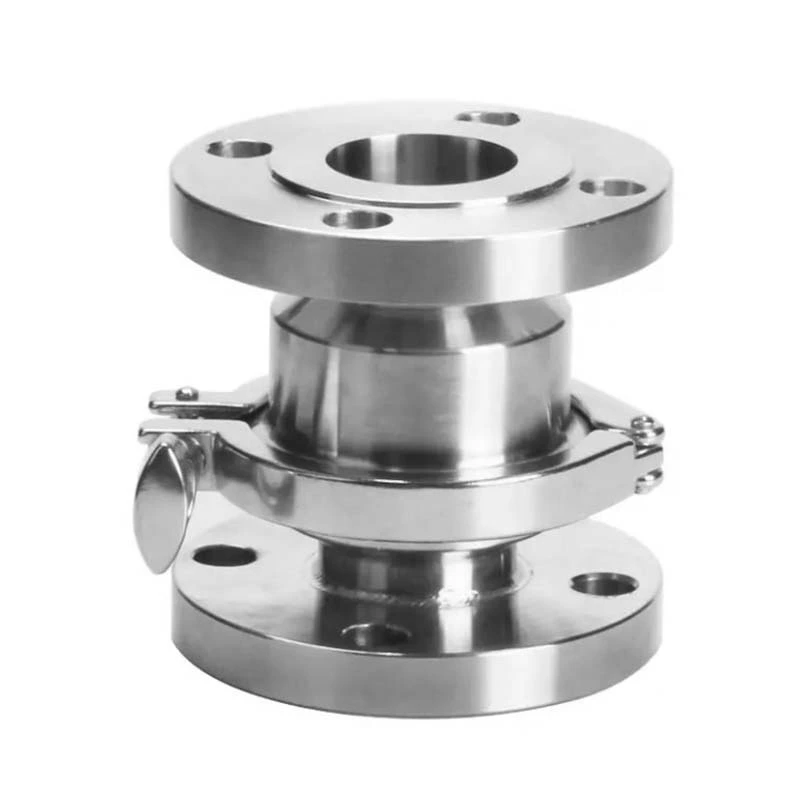Sanitary Check Valve Models And Specifications
1. Introduction
A Sanitary Check Valve is a valve used to protect piping systems. It automatically closes and prevents fluid from flowing in the opposite direction. In piping systems, reverse flow may occur due to pressure fluctuations or fluid inertia. In such cases, a check valve is necessary to prevent reverse flow and protect the normal operation of the piping system.
2. Common Check Valve Types and Specifications
2.1 One-Way Check Valve
A one-way check valve is the most common type of check valve. It allows fluid to flow in only one direction. When the flow direction changes, the valve automatically closes to prevent reverse flow. Depending on their structure, one-way check valves can be divided into ball check valves, lift check valves, and rotary check valves.
2.1.1 Ball Check Valve
A ball check valve is a valve that opens and closes by the floating motion of a ball. It features a simple structure, excellent sealing, and low fluid resistance. Common ball check valves have the following specifications: - Model: BV-100 - Connection: Threaded - Pipe Diameter: DN100 - Pressure Rating: PN16 - Model: BV-150 - Connection: Flange - Pipe Diameter: DN150 - Pressure Rating: PN25
2.1.2 Lift Check Valve
Lift check valves open and close by moving a lifting disc. They feature a simple structure, reliable sealing, and are suitable for large diameters. Common lift check valves have the following specifications: - Model: AV-200 - Connection: Flange - Pipe Diameter: DN200 - Pressure Rating: PN40 - Model: AV-250 - Connection: Wafer - Pipe Diameter: DN250 - Pressure Rating: PN16
2.1.3 Rotary Check Valve
Rotary check valves open and close by rotating the disc. They offer a wide disc opening angle, low fluid resistance, and are suitable for high-speed flows. Common rotary check valves have the following specifications: - Model: RV-80 - Connection: Threaded - Pipe Diameter: DN80 - Pressure Rating: PN10 - Model: RV-125 - Connection: Flange - Pipe Diameter: DN125 - Pressure Rating: PN20
2.2 Bidirectional Check Valve
A bidirectional check valve allows fluid to flow in two opposite directions but automatically closes to prevent excessive reverse flow. Common bidirectional check valves have the following specifications: - Model: DBV-150 - Connection: Flange - Pipe Diameter: DN150 - Pressure Rating: PN16
3. Common Materials
The material choice of a check valve directly affects its service life and reliability. Common materials include stainless steel, carbon steel, and cast iron.
• Stainless steel: Features strong corrosion resistance and high temperature resistance, making it suitable for corrosive and high-temperature media.
• Carbon steel: Features high strength and good wear resistance, making it suitable for media under general operating conditions. • Cast iron: Features include affordability and moderate strength, making it suitable for low-pressure, low-temperature media.
4. Selection Considerations
When selecting a check valve model and specifications, consider the following factors: 1. Pipe Diameter: Determine the appropriate pipe diameter based on the pipeline's flow rate and operating pressure. 2. Pressure Rating: Determine the correct pressure rating based on the pipeline's operating pressure. 3. Material Selection: Select the appropriate material based on the media's characteristics and operating environment. 4. Connection Method: Select the appropriate connection method based on the requirements of the piping system.
In summary, when purchasing a check valve, choose the appropriate model and specification based on the specific project requirements and operating environment to ensure the safety and proper operation of the piping system.
The above is a document on check valve models and specifications. We hope it will be helpful!
